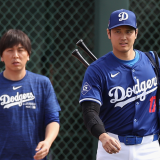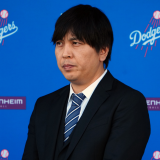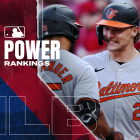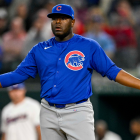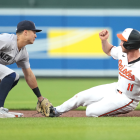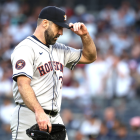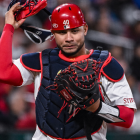It has been 22 years since Major League Baseball last dealt with a labor stoppage. National and local TV deals have surged through the roof. Teams are fetching astronomical sale prices. Player salaries have soared to record highs. All told, MLB is now a $10 billion industry.
Money's flowing even more heavily into the NBA and NFL. Three years ago, the Clippers sold for $2 billion. In March, the soon-to-be Las Vegas Raiders unveiled plans for a $1.9 billion stadium. Middle-of-the-road players are fetching gigantic contracts. Like MLB, the NBA and NFL can also be measured in 11 figures. While both the NBA and NFL experienced labor strife just six years ago, a tidal wave of cash has lifted all boats since then.
Enjoy it while it lasts.
As the recent layoffs at ESPN showed, the current economics of sports are unsustainable. Cable subscribers are dwindling every day, creating cash crunches for even the biggest media behemoths. Those shortfalls at ESPN and elsewhere have thrown the careers of hundreds of talented and hardworking writers, editors, broadcasters and producers into chaos.
None of those layoffs would seem to affect tunnel-visioned fans, who for now still get to watch their favorite leagues and teams, without fear of interruption. But that could soon change. If a sports cable network buying TV rights leads to bad outcomes for the shareholders of its parent company, that network will be less inclined to bid for those rights next time around. If bidders start backing down, teams will end up with less money in their war chests. If that happens, teams could go back to the same approach they've adopted many times in pro sports history: Try to take money out of players' pockets. And if that happens, years of labor peace could evaporate, and the games that sports fans have come to expect might get thrown aside over money disputes.
Or as John Helyar, author of the best-selling book on the history of owner-player relations in baseball The Lords of the Realm put it: "Labor strife is all about scarcity."
In sports, as in life, scarcity can lead to all kinds of ugly outcomes. Three decades ago, it produced one of the ugliest episodes in the history of owner-player relations.
In an effort to drive down player salaries, Major League Baseball owners colluded against free agents in the 1980s. The fallout was especially nasty following the 1986 season. Ace starting pitcher Jack Morris had so much trouble finding offers, he was forced to accept salary arbitration and return to Detroit at a fraction of his true market value. Andre Dawson grew so desperate and fed up with his lack of suitors, he and his agent showed up to spring training, handed Cubs management a blank contract, and told them to fill in any number they wanted. Even adjusting for inflation, the $500,000 the Cubs paid Dawson that year was nowhere near his actual worth -- especially when Dawson cranked 49 homers, knocked in 137 runs and won the National League MVP.
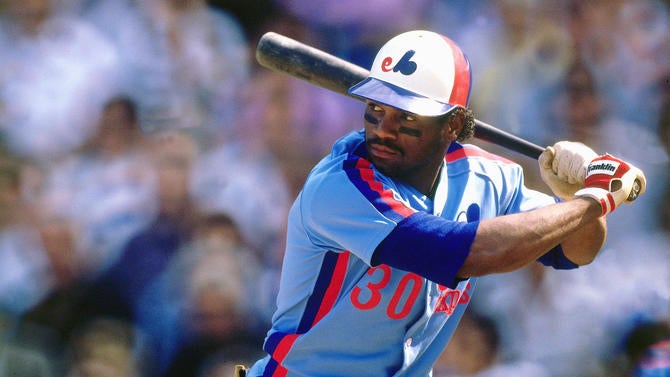
Tim Raines made out worst of all. Several years younger than Morris and Dawson and at the height of his powers at age 27, Raines figured to make gigantic money after making the All-Star team in each of his first six seasons as an everyday player. The Astros and Padres sniffed around briefly, but the most any team offered was actually a slight pay cut from his salary the year before. So Raines tried to wait out the market. Problem was, doing so triggered an obscure clause that forced him to sit out the first month of the following season. Forbidden from even using big-league facilities or training with his teammates while he sat, Raines was forced to work out on high-school fields, facing nothing close to top-level competition for seven months.
Arbitrators would go on to fine MLB owners multiple times for colluding against players, with the big blow in 1990 costing them $280 million. As commissioner Fay Vincent told the owners: "The single biggest reality you guys have to face up to is collusion. You stole $280 million from the players, and the players are unified to a man around that issue, because you got caught and many of you are still involved."
It might seem far-fetched at first to go from a world in which leagues, teams and players are making sky-high piles of money to players and owners at war with each other over a shrinking pie. But as with any market downturn, the first sign of trouble can occur when everything looks too good to be true.
"The sports market is in a bubble," said Andrew Zimbalist, a sports economist at Smith College. "It's been a perfect storm of factors that have contributed to higher rights fees in the last two decades."
The biggest disruptor of that perfect storm is technology. As Zimbalist noted, sports fans have so many ways to watch games now; that strips control away from cable networks, and makes it tougher for those networks to pass rights fees onto customers. Meanwhile, consumers also have exponentially more entertainment platforms to choose from, sports-related or otherwise. That means fewer people are likely to watch games live -- doubly so for younger generations lured away by Twitch and other exploding platforms. Rising numbers for newer sports like eSports and mixed martial arts have also pulled viewers away from traditional big-three viewing.
Even if those worrying trends continue, it could take several years before we see the full negative effects. The NBA's deals with ESPN and Turner Sports run through 2025. The NFL's deals with Fox, NBC and CBS run through 2022. MLB's TV deals with Fox, ESPN and Turner run through 2021. The collective bargaining agreements for each of those three sports have multiple years left on them too: The NFL's runs through 2020, and the recently ratified agreements in MLB and the NBA last through 2021 and 2024.
That leaves the big three sports leagues little choice but to explore alternative broadcast arrangements, if they hope to avoid the potential cord-cutting bloodbath that could look far, far worse three, four and seven years from now. MLB Advanced Media is a growing force in the sports world, and ESPN has hitched its fortunes to BAM's growth. You can now stream NFL games on Yahoo and Twitter. Funneling fans from traditional TV channels to over-the-top devices could absorb some of the blow too.
The sports landscape could thus come down to a simple race: Can pro sports leagues shift to newer platforms quickly enough to defray the damage caused by cord-cutting? Or will younger generations' viewing habits change even more rapidly, moving away not only from games on TV, but also from watching games altogether?
"I think it's possible," Zimbalist said. "It's been an adjustment already. Labor's shares has [gone down] already, management has had the upper hand and they've exercised that. I don't know how much further that button will be pushed."
That's exactly what no one wants to find out. MLB's revenue split leaned 58-42 in favor of players in 2002; it has since flipped to nearly the inverse of that 15 years later, according to multiple industry sources. The players union might not push back too hard, and owners might not want to press their luck further, while total revenue keeps mushrooming. But the sport's finances could get dicier in a hurry: The troubles facing regional sports networks' futures in particular, combined with an aging fan base, could hit MLB especially hard.
As MLB has demonstrated even in the best of times, labor peace can be tenuous, and the specter of collusion is never as far away as we might think. Solving the unplugging dilemma, and society's shifting taste in entertainment, could be one of the biggest challenges the sports world will ever face.








